Beginners who decide to get into growing microgreens should stick to simple plants. And arugula microgreens would be the best option. This plant is in demand among experienced cooks. It has a spicy taste with nutty notes. In this article, you can read more about growing these plants, their shelf life, and their health benefits.
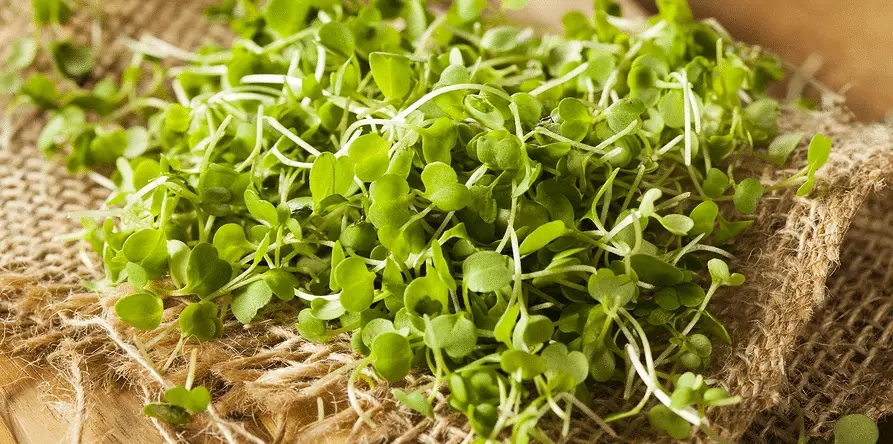
Contents
What are arugula microgreens?
The term arugula microgreens refer to a young arugula plant that can be used for culinary delights just a few days after germination. Popular microgreens have a crispy texture and are ideal for salads.
Similarity
Arugula bears some resemblance to cabbage and radish. If you eat the plant fresh, you can saturate your body with useful elements. You need to understand that the microgreens of the garden rocket have differences from arugula sprouts. Arugula sprouts are germinated seeds that have leaves.
Microgreens are grown in the ground. These are full-fledged plants that have leaf plates, a tap root system, and stems. Microgreens have the same flavor as mature arugula. However, it is more pronounced. The composition has a high content of nutrients.
Even a small portion of arugula microgreens is enough to saturate the healthy body with useful components. This is the best solution for those who have just started introducing vegetables into their diet. You can use it to make salads or sandwiches.
Arugula microgreens are hard to find in the supermarket. Therefore, it makes sense to grow it at home. However, the process takes no more than 10 days.
Health benefits of arugula microgreens
Microgreens are much healthier than adult plants. It is believed that it has almost 5-40 times more nutritional components. Arugula microgreens are high in calcium, which helps strengthen teeth and bone health, useful for the immune system. There is folic acid, as well as carotenoids.
The content of vitamin C and mineral components, including iron, manganese, and potassium, is high. This product is believed to help prevent cancer.
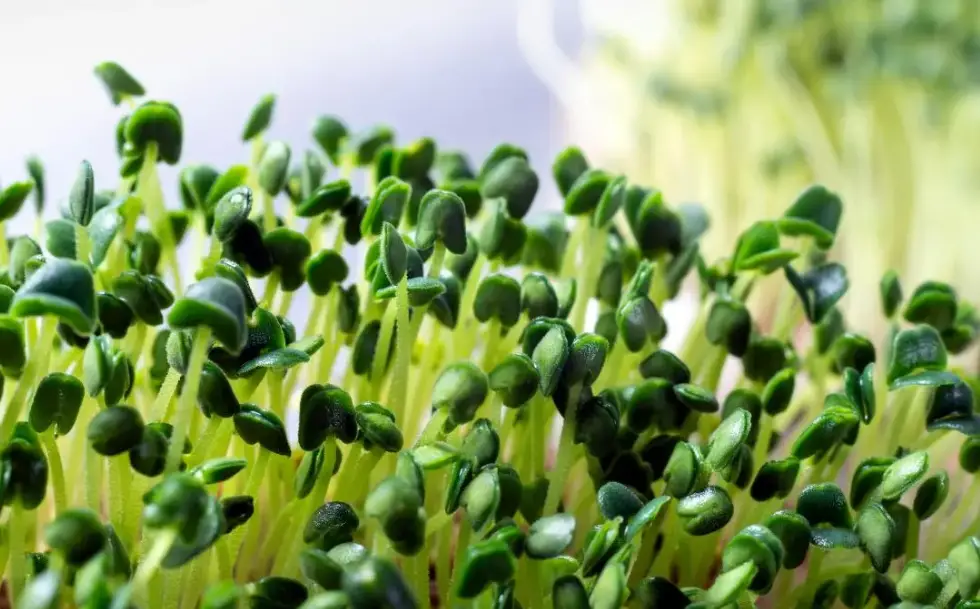
List of required consumables
If you decide to grow arugula microgreens, then you need to prepare a few supplies.
Seeds
For growing arugula microgreens, any arugula microgreen seeds that you find on the market work. However, it is better to pay attention to the types of greens. Refuse to use wild arugula because it significantly complicates the harvesting process.
Opt for organic vegetable seeds. They should not contain pesticides and other harmful additives.
Growing medium
You need to select soil that is designed for growing microgreens. The use of potting soil is allowed. However, it is better to use soil to grow arugula microgreens. It has a light and fine-grained texture. Therefore, the root hairs will develop better.
You can also use grow mats, paper towels, and coconut coir. The grow mats, towels, and coconut coir prevents pollution of the house. Some housewives use vermiculite. It makes the growing medium airier.
Capacities
To make it easier to harvest growing arugula microgreens, use shallow containers. The optimal depth should be 1-2 inches. Drainage holes must be made in the containers. This keeps the potting soil from becoming swampy, which prevents mold and rot.
Additionally, a larger container is required, it fits a container with a plant, and this is the best solution for irrigation. In the case of bottom watering, the leaf plates and stems are dry, which also helps prevent mold.
Spray
This tool is required for watering. Due to the small size of the arugula seeds, watering is best done with a fine mist.
The light source for growing arugula microgreens
For microgreens to acquire a rich green hue, they have to be properly lit. This provides the optimal amount of photosynthesis.
You can place containers on the windowsill. Natural light coming through the glass will suffice.
If the house does not have a large windowsill, you need to install a special grow lamp. This ensures uniform lighting, regardless of the season.
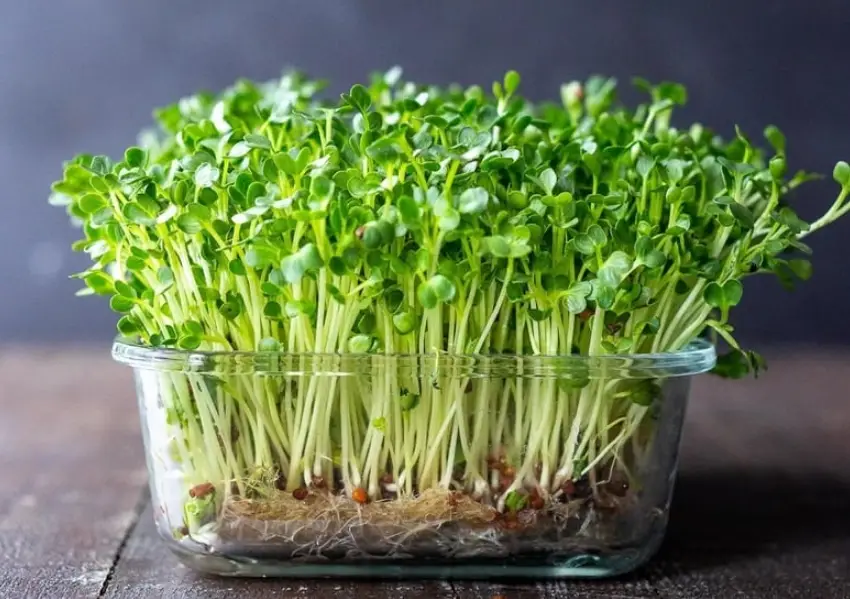
The principle of sowing seeds of arugula microgreens
First, the container is filled with a nutrient-growing medium to the brim. Smooth the surface with your hand, and lightly tamp with patting movements.
If you are using shavings from coconut, then you should not compact the soil because it becomes excessively dense.
Spray the soil with a small amount of water, and wait until it is completely absorbed. Next, you need to spray the surface a little more. After that, it is possible to start sowing.
Do arugula seeds need to be soaked?
Arugula seeds do not need to be soaked. After all, the shell is very soft anyway. Due to the small size of the seeds, they will damage.
Seeds have to be poured over the soil in one layer. To facilitate the work, use a shaker. On average, 30 grams of seed are required for a 10×20-inch container.
If the seeds stick together, they must be spread a little using your fingers. If this is not done, the arugula seed begins to rot.
Sprouting seeds
No need to cover the seeds with soil. It is enough to pour them with a small amount of water using a spray bottle. Be careful not to blow off the seeds, as they are very light.
It is better to cover the container to keep moisture inside and prevent excess sunlight, and also to stimulate germination and maintain optimum arugula seed moisture. It is appropriate to cover the shallow trays with a larger container. You can also place a heavy object on top that weighs no more than 5 pounds.
This will secure the lid, so it doesn’t move. If everything is done correctly, the seeds are introduced into the soil and germinate.
Therefore, microgreens are durable. You can also leave the container in a warm place for a few days. Even watering will not be required.
Lift the lid after a few days to check the seeds. When small yellow leaves begin to form, it is possible to proceed to other stages of work.
If this does not happen, then the seeds should be treated with water and the cover should be changed. Then leave the seeds for a few more days.
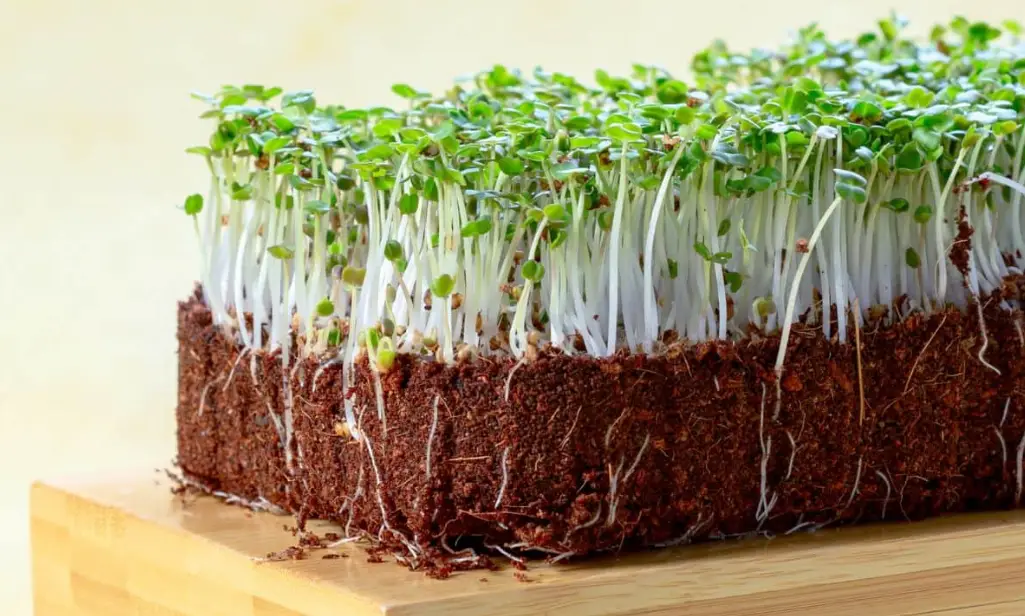
What to do next?
After the specified time, transfer the container to a well-lit place. Once most of the seeds have germinated, the lid can be removed. If you use a special lighting lamp, then it should be turned on for 4-8 hours every day.
After that, it is necessary to water the arugula seed well. It is better to stay on the bottom watering method. After moistening the soil, remove the top tray so that the seeds do not get too wet. If there is a lot of water, the seeds rot and are affected by mold.
Carry out the bottom watering, as needed. The soil must always be moist. Initially, it seems that the seeds are covered with white mold. However, these are root hairs that cannot be removed. After 2-3 days, microgreens form. Some plants are pale. If you light them enough, they will turn green.
Be aware that you grow arugula microgreens longer than other plants. Especially if the question concerns the acquisition of a green tint. This is a completely natural process. The green shade of the leaves forms only on the 4th day.
If this does not happen, then the microgreens are not getting enough light. Therefore, you should install special lamps in addition to sunlight. The paler the greens, the fewer nutrients they contain, and the taste does not be the best.
If you want to grow arugula microgreens properly, they should be kept warm. Optimal temperatures are around 70℉. It is important to ensure high-quality ventilation, and the humidity level should be about 50%.
How to harvest arugula microgreens?
A week after sowing, you can start plants harvested. However, it is better to check the readiness first. The optimum plant height should be 2-3 inches. Microgreens should have a rich shade and several cotyledon leafy greens.
Harvesting is carried out before the appearance of true leaves. Otherwise, the taste will be poor. Watering should stop half a day before harvest. Plants must be kept dry to keep longer. Cut plants above the ground using a sharp knife.
If necessary, you can immediately harvest the entire crop. However, it is better to harvest plants gradually.
You need to understand that microgreens do not grow back after cutting. Therefore, you receive a new crop only 7-10 days after the next sowing.
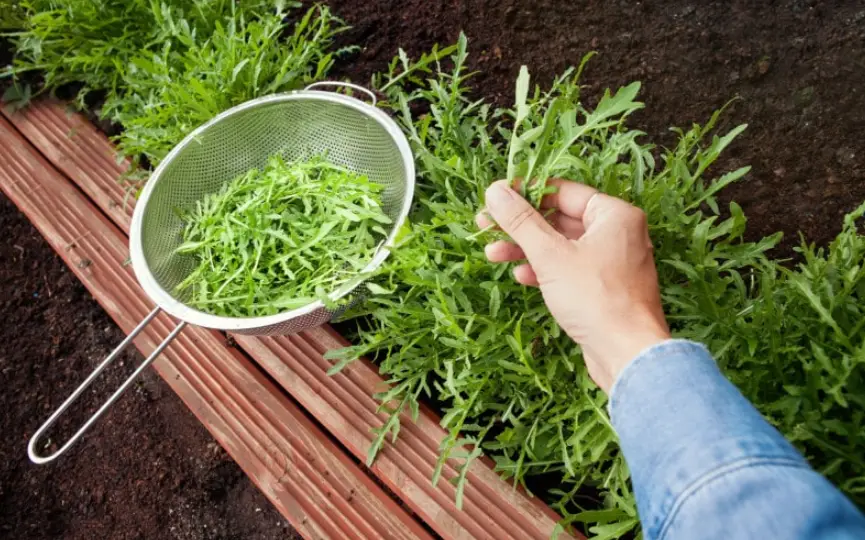
How to store microgreens: microgreen’s shelf life
Microgreens are best consumed when they are freshly cut. If you cut too many plants, you can prepare them for the future. Arugula microgreens can be stored in the refrigerator for up to 4 days. You have to wrap it in paper towels.
It absorbs excess moisture, which positively affects the shelf life. Microgreens need to be packaged in a special plastic bag or container and placed in boxes for vegetables and fruits.
You can also freeze microgreens. To do this, it does not have to be washed in advance. It is enough to place in special bags for freezing, and place in the freezer. Shelf life is up to six months.
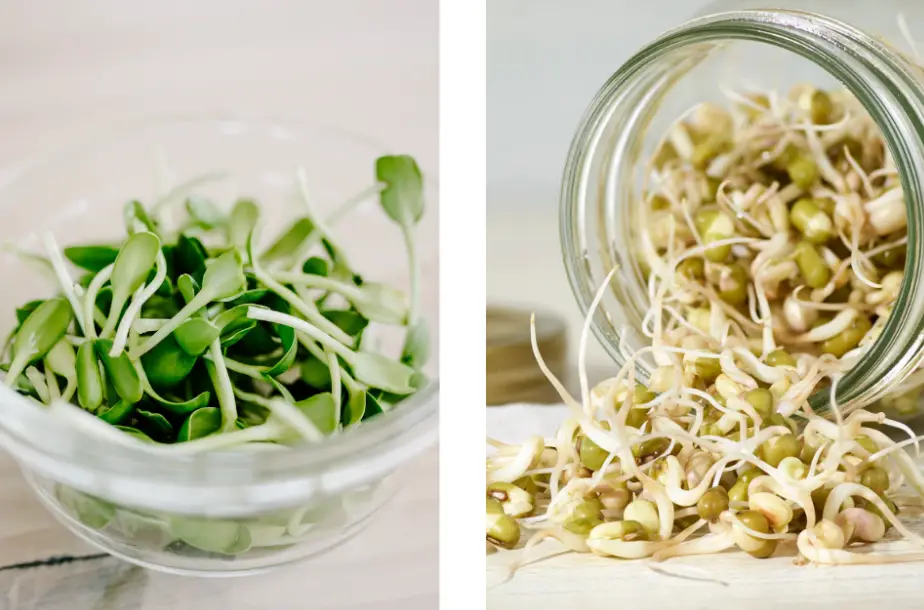
FAQ
When you grow microgreens and use them, many questions can be asked.
Can you eat arugula microgreens?
Yes, you can use arugula microgreens. It has a pleasant taste. Plants are appropriate for making soups, salads, sandwiches, or pizza. Some housewives add the arugula microgreen to cocktails. During heat treatment, arugula becomes less spicy and acquires a smooth taste.
How long does it take arugula microgreens to grow?
On average, arugula microgreens ripen 3-7 days after sowing. 2 full leaves should develop.
What does arugula microgreen taste like?
Arugula microgreens have a mild flavor when compared to mature grass. It has a sweet-spicy taste, with nutty notes.
Do arugula microgreens grow back?
If you cut arugula microgreens, they won’t regenerate again. You have to re-sow.
Results
As you can see, growing arugula microgreens is not difficult. You need some equipment, as well as a few days of patience. After 7-10 days, you can enjoy the pleasant taste of fresh microgreens that will complement any dish.
Read also: How to tell if radishes are bad? (signs and storing tips)



Did you know that arugula microgreens are considered one of the healthiest natural foods? It is an excellent source of folic acid, iron, copper, minerals, and vitamins. Greens are useful for strengthening immunity because they contain ascorbic acid and flavonoids, which prolong youth and strengthen the walls of blood vessels!
I am just obsessed with arugula because of its incredible taste. I add it to meat, fish, seafood, and cheese, and combine it with vegetables and fruits (especially citrus fruits)!
If you love arugula as much as I do, sow it in different containers every 3-4 days. This way you will always have fresh microgreens.